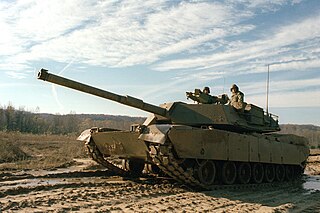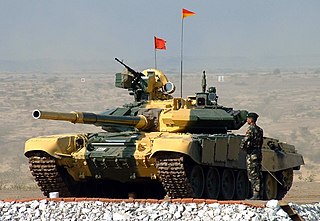Related Research Articles

A shaped charge is an explosive charge shaped to focus the effect of the explosive's energy. Different types of shaped charges are used for various purposes such as cutting and forming metal, initiating nuclear weapons, penetrating armor, or perforating wells in the oil and gas industry.

A kinetic energy penetrator (KEP), also known as long-rod penetrator (LRP), is a type of ammunition designed to penetrate vehicle armour using a flechette-like, high-sectional density projectile. Like a bullet or kinetic energy weapon, this type of ammunition does not contain explosive payloads and uses purely kinetic energy to penetrate the target. Modern KEP munitions are typically of the armour-piercing fin-stabilized discarding sabot (APFSDS) type.

Reactive armour is a type of vehicle armour used in protecting vehicles, especially modern tanks, against shaped charges and hardened kinetic energy penetrators. The most common type is explosive reactive armour (ERA), but variants include self-limiting explosive reactive armour (SLERA), non-energetic reactive armour (NERA), non-explosive reactive armour (NxRA), and electric armour. NERA and NxRA modules can withstand multiple hits, unlike ERA and SLERA.

Armour-piercing ammunition (AP) is a type of projectile designed to penetrate armour protection, most often including naval armour, body armour, vehicle armour.

Composite armour is a type of vehicle armour consisting of layers of different materials such as metals, plastics, ceramics or air. Most composite armours are lighter than their all-metal equivalent, but instead occupy a larger volume for the same resistance to penetration. It is possible to design composite armour stronger, lighter and less voluminous than traditional armour, but the cost is often prohibitively high, restricting its use to especially vulnerable parts of a vehicle. Its primary purpose is to help defeat high-explosive anti-tank (HEAT) projectiles.

Terminal ballistics is a sub-field of ballistics concerned with the behavior and effects of a projectile when it hits and transfers its energy to a target.

Chobham armour is the informal name of a composite armour developed in the 1960s at the Military Vehicles and Engineering Establishment, British tank research centre. The name has since become the common generic term for composite ceramic vehicle armour. Other names informally given to Chobham armour include Burlington and Dorchester. Special armour is a broader informal term referring to any armour arrangement comprising sandwich reactive plates, including Chobham armour.

A high-explosive squash head (HESH), in British terminology, or a high-explosive plastic/plasticized (HEP), in American terminology, is a type of explosive projectile with plastic explosive that conforms to the surface of a target before detonating, which improves the transfer of explosive energy to the target. Squash head projectiles are similar to high-explosive projectiles and are well suited to many of the same targets. However, while HESH projectiles are not armour-piercing, they can defeat armored targets by causing spall, which can injure or kill a vehicle's occupants or detonate some types of ammunition.

High-explosive anti-tank (HEAT) is the effect of a shaped charge explosive that uses the Munroe effect to penetrate heavy armor. The warhead functions by having an explosive charge collapse a metal liner inside the warhead into a high-velocity shaped charge jet; this is capable of penetrating armor steel to a depth of seven or more times the diameter of the charge. The shaped charge jet armor penetration effect is purely kinetic in nature; the round has no explosive or incendiary effect on the armor.

Kontakt-5 is a type of second-generation explosive reactive armour (ERA) originating in the Soviet Union. Due to the shortcomings of Kontakt-1, NII Stali further developed the reactive armor to Kontakt-5, so that it also repels APFSDS projectiles, which is not as effective in combat as stated. In addition, Kontakt-5 is not just additional armor, but is clearly integrated into the vehicle hull. The Kontakt-5 modules have a significantly thicker steel upper side. Depending on the module, they contain one or two 4S22 reactive elements. The explosive of a 4S22 element has the TNT equivalent of 330 g. It is so sensitive that even armor-piercing projectiles cause it to explode. Contact-5 produces a stronger defensive detonation than Contact-1 and the thicker layer of steel thrown at the arrow projectile breaks or bends it. The increase in defensive capability led to the development of reinforced arrow projectiles.
Rolled homogeneous armour (RHA) is a type of vehicle armour made of a single steel composition hot-rolled to improve its material characteristics, as opposed to layered or cemented armour. Its first common application was in tanks. After World War II, it began to fall out of use on main battle tanks and other armoured fighting vehicles intended to see front-line combat as new anti-tank weapon technologies were developed which were capable of relatively easily penetrating rolled homogeneous armour plating even of significant thickness.

Sloped armour is armour that is oriented neither vertically nor horizontally. Such angled armour is typically mounted on tanks and other armoured fighting vehicles (AFVs), as well as naval vessels such as battleships and cruisers. Sloping an armour plate makes it more difficult to penetrate by anti-tank weapons, such as armour-piercing shells, kinetic energy penetrators and rockets, if they follow a more or less horizontal trajectory to their target, as is often the case. The improved protection is caused by three main effects.

Military vehicles are commonly armoured to withstand the impact of shrapnel, bullets, shells, rockets, and missiles, protecting the personnel inside from enemy fire. Such vehicles include armoured fighting vehicles like tanks, aircraft, and ships.
The following is a list of ammunition fired by the 125 mm smoothbore gun series used in the T-64, T-72, T-80, M-84, T-90, PT-91, T-14 Armata, and other tanks derived from those designs, as well as the 2A45 Sprut anti-tank gun.

Armour with two or more plates spaced a distance apart falls under the category of spaced armour. Spaced armour can be sloped or unsloped. When sloped, it reduces the penetrating power of bullets and solid shot, as after penetrating each plate projectiles tend to tumble, deflect, deform, or disintegrate; spaced armour that is not sloped is generally designed to provide protection from explosive projectiles, which detonate before reaching the primary armour. Spaced armour is used on military vehicles such as tanks and combat bulldozers. In a less common application, it is used in some spacecraft that use Whipple shields.
In warfare, high-explosive incendiary (HEI) is a type of ammunition specially designed to impart energy and therefore damage to its target in one or both of two ways: via a high-explosive charge and/or via its incendiary (fire-causing) effects. Each round has both capabilities.
Beyond-armour effect is a term coined by Försvarets Fabriksverk (FFV), a semi-governmental Swedish defense firm, while developing the AT4. From the 1980s this phrase was used in its brochures, press releases, weapon instruction manuals and other documentation to denote the post-penetration effect of the AT4's HEAT anti-armour warhead against the interior and occupants of armoured vehicles.
The Modular Expandable Armor System (MEXAS) is a composite armour system developed by the German company IBD Deisenroth Engineering. MEXAS was introduced in 1994 and has been applied on over 20,000 combat vehicles worldwide. The successor of MEXAS is the Advanced Modular Armor Protection (AMAP).
Stillbrew armour, or more correctly, the Stillbrew Crew Protection Package (SCPP) was an add-on passive composite armour applied to the FV4201 Chieftain main battle tank used by the British Army's Royal Armoured Corps in the mid-1980s and early-1990s so as to provide increased protection from anti-tank warfare weapons. It was named after the two men that invented it, Colonel Still and John Brewer, from the Military Vehicles and Engineering Establishment in Surrey. The tanks to which it was fitted were colloquially referred to as Stillbrew Chieftains.
Non-explosive reactive armour (NxRA), also known as non-energetic reactive armor (NERA), is a type of vehicle armor used by modern main battle tanks and heavy infantry fighting vehicles. NERA advantages over explosive reactive armor (ERA) are its inexpensiveness, multi-hit capability, and ease of integration onto armored vehicles due to its nonexplosive nature.
References
- 1 2 3 "Surface Forces: Electromagnetic Armor". www.strategypage.com. Retrieved 2021-12-06.
- ↑ "The armour strikes back". The Economist. 2011-06-02. Retrieved 2015-08-31.
- 1 2 3 4 "Electrified Vehicle Armour Could Deflect Weapons". 2011-09-27. Archived from the original on 27 September 2011. Retrieved 2021-12-06.
- 1 2 3 4 5 6 7 Shachtman, Noah. "U.S. Military Uses the Force". Wired. ISSN 1059-1028 . Retrieved 2021-12-06.
- 1 2 3 "'Star Trek' shields to protect supertanks". the Guardian. 2001-08-19. Retrieved 2021-12-06.
- 1 2 3 4 "news.telegraph.co.uk - 'Electric armour' vaporises anti-tank grenades and shells". 2002-08-22. Archived from the original on 22 August 2002. Retrieved 2021-12-06.
- 1 2 "I.T. Vibe - MoD Develops 'Electric Armour'". 2010-04-10. Archived from the original on 10 April 2010. Retrieved 2021-12-06.
- 1 2 3 4 5 "New Age Electric Armour - Tough enough to face modern threats - Armed Forces International". 2009-05-02. Archived from the original on 2 May 2009. Retrieved 2021-12-06.
- 1 2 3 4 5 "Advanced Armour Concepts for Light Vehicles". 2007-10-15. Archived from the original on 15 October 2007. Retrieved 2021-12-06.
- ↑ "Science Spotlight". 2006-04-27. Archived from the original on 27 April 2006. Retrieved 2021-12-06.